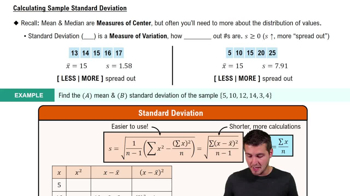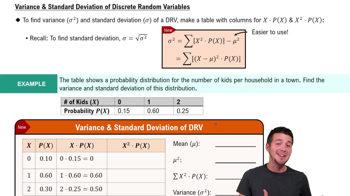Mean Absolute Deviation Use the same population of {9 cigarettes, 10 cigarettes, 20 cigarettes} from Exercise 45. Show that when samples of size 2 are randomly selected with replacement, the samples have mean absolute deviations that do not center about the value of the mean absolute deviation of the population. What does this indicate about a sample mean absolute deviation being used as an estimator of the mean absolute deviation of a population?
Table of contents
- 1. Intro to Stats and Collecting Data1h 14m
- 2. Describing Data with Tables and Graphs1h 55m
- 3. Describing Data Numerically2h 5m
- 4. Probability2h 16m
- 5. Binomial Distribution & Discrete Random Variables3h 6m
- 6. Normal Distribution and Continuous Random Variables2h 11m
- 7. Sampling Distributions & Confidence Intervals: Mean3h 23m
- Sampling Distribution of the Sample Mean and Central Limit Theorem19m
- Distribution of Sample Mean - Excel23m
- Introduction to Confidence Intervals15m
- Confidence Intervals for Population Mean1h 18m
- Determining the Minimum Sample Size Required12m
- Finding Probabilities and T Critical Values - Excel28m
- Confidence Intervals for Population Means - Excel25m
- 8. Sampling Distributions & Confidence Intervals: Proportion1h 25m
- 9. Hypothesis Testing for One Sample3h 29m
- 10. Hypothesis Testing for Two Samples4h 50m
- Two Proportions1h 13m
- Two Proportions Hypothesis Test - Excel28m
- Two Means - Unknown, Unequal Variance1h 3m
- Two Means - Unknown Variances Hypothesis Test - Excel12m
- Two Means - Unknown, Equal Variance15m
- Two Means - Unknown, Equal Variances Hypothesis Test - Excel9m
- Two Means - Known Variance12m
- Two Means - Sigma Known Hypothesis Test - Excel21m
- Two Means - Matched Pairs (Dependent Samples)42m
- Matched Pairs Hypothesis Test - Excel12m
- 11. Correlation1h 6m
- 12. Regression1h 50m
- 13. Chi-Square Tests & Goodness of Fit1h 57m
- 14. ANOVA1h 57m
3. Describing Data Numerically
Standard Deviation
Problem 5.c.1e
Textbook Question
Planets The planets of the solar system have the numbers of moons listed below in order from the sun. (Pluto is not included because it was uninvited from the solar system party in 2006.) Include appropriate units whenever relevant.
0 0 1 2 17 28 21 8
e. Find the standard deviation.
f. Find the variance.
 Verified step by step guidance
Verified step by step guidance1
Step 1: Begin by identifying the data set provided, which represents the number of moons for each planet in the solar system: {0, 0, 1, 2, 17, 28, 21, 8}. Note that these values are the raw data points.
Step 2: Calculate the mean (average) of the data set. The formula for the mean is: , where represents each data point and is the total number of data points.
Step 3: Compute the squared differences between each data point and the mean. For each data point , calculate: . This step is essential for both variance and standard deviation calculations.
Step 4: Find the variance using the formula: . This represents the average of the squared differences.
Step 5: Calculate the standard deviation by taking the square root of the variance. The formula is: . This provides a measure of the spread of the data points around the mean.
 Verified video answer for a similar problem:
Verified video answer for a similar problem:This video solution was recommended by our tutors as helpful for the problem above
Video duration:
3mPlay a video:
Was this helpful?
Key Concepts
Here are the essential concepts you must grasp in order to answer the question correctly.
Standard Deviation
Standard deviation is a measure of the amount of variation or dispersion in a set of values. It quantifies how much the individual data points differ from the mean of the dataset. A low standard deviation indicates that the values tend to be close to the mean, while a high standard deviation suggests a wider spread of values. It is commonly used in statistics to understand the distribution of data.
Recommended video:
Guided course

Calculating Standard Deviation
Variance
Variance is the average of the squared differences from the mean, providing a measure of how much the data points in a dataset vary. It is calculated by taking the mean of the squared deviations from the mean. Variance is a foundational concept in statistics, as it helps to understand the spread of data and is directly related to the standard deviation, which is the square root of variance.
Recommended video:
Guided course

Variance & Standard Deviation of Discrete Random Variables
Data Set
A data set is a collection of related values or observations that can be analyzed statistically. In this context, the data set consists of the number of moons for each planet in the solar system. Understanding the structure and characteristics of the data set is crucial for calculating statistical measures like variance and standard deviation, as these calculations depend on the specific values within the set.
Recommended video:
Guided course

Visualizing Qualitative vs. Quantitative Data

 8:45m
8:45mWatch next
Master Calculating Standard Deviation with a bite sized video explanation from Patrick
Start learningRelated Videos
Related Practice
Textbook Question
